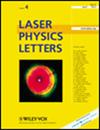熔融氟化盐辅助合成碳化钛 (Ti2C) MXene 及其在掺铥光纤激光器 2 µm 模式锁定中的应用
IF 1.4
4区 物理与天体物理
Q3 OPTICS
引用次数: 0
摘要
碳化钛(Ti2C)是一种名为 MXenes 的新型二维材料,因其在众多领域的潜在应用而备受关注。在 Ti2C MXene 的众多独特特性中,其非线性特性对光电应用,特别是超快激光发生具有吸引力。在这项工作中,通过使用氟化锂和盐酸的混合物蚀刻 MAX 相前驱体碳化钛铝(Ti2AlC),制造出了 Ti2C MXene,从而避免了使用有害氢氟酸的风险。Ti2C MXene 以溶液形式制备,然后滴在锥形纤维的较小芯径上,再用作可饱和吸收体(SA)。将 SA 器件插入掺铥光纤激光器,可产生中心波长为 1951 nm、脉冲宽度为 1.67 ps 的稳定锁模脉冲。经过一段时间的测试,锁模激光器非常稳定,测量到的峰值光功率波动仅为 0.005 dB。结果表明,Ti2C MXene 在产生超快激光方面表现出卓越的性能。本文章由计算机程序翻译,如有差异,请以英文原文为准。
Molten fluoride salt-assisted synthesis of titanium carbide (Ti2C) MXene and its application for 2 µm mode-locking in a thulium-doped fiber laser
Titanium carbide (Ti2C), a new two-dimensional material named MXenes, has attracted interest due to its potential applications in numerous fields. Of the many unique characteristics of Ti2C MXene, its nonlinear properties are attractive for optoelectronic applications, specifically for ultrafast laser generation. In this work, a Ti2C MXene was fabricated by etching a MAX phase precursor titanium aluminum carbide (Ti2AlC) using a mixture of lithium fluoride and hydrochloric acid, eliminating the risk of using the harmful hydrofluoric acid. The Ti2C MXene was prepared in solution form and then dropped onto a reduced core diameter of tapered fiber before being used as a saturable absorber (SA). The SA device was inserted into a thulium-doped fiber laser to generate stable mode-locked pulses at a center wavelength of 1951 nm with a pulse width of 1.67 ps. The mode-locked laser was highly stable when tested over time, with peak optical power fluctuations of as little as 0.005 dB measured. The results show that the Ti2C MXene exhibit outstanding performance for ultrafast laser generation.
求助全文
通过发布文献求助,成功后即可免费获取论文全文。
去求助
来源期刊

Laser Physics Letters
物理-仪器仪表
CiteScore
3.30
自引率
11.80%
发文量
174
审稿时长
2.4 months
期刊介绍:
Laser Physics Letters encompasses all aspects of laser physics sciences including, inter alia, spectroscopy, quantum electronics, quantum optics, quantum electrodynamics, nonlinear optics, atom optics, quantum computation, quantum information processing and storage, fiber optics and their applications in chemistry, biology, engineering and medicine.
The full list of subject areas covered is as follows:
-physics of lasers-
fibre optics and fibre lasers-
quantum optics and quantum information science-
ultrafast optics and strong-field physics-
nonlinear optics-
physics of cold trapped atoms-
laser methods in chemistry, biology, medicine and ecology-
laser spectroscopy-
novel laser materials and lasers-
optics of nanomaterials-
interaction of laser radiation with matter-
laser interaction with solids-
photonics
 求助内容:
求助内容: 应助结果提醒方式:
应助结果提醒方式:


